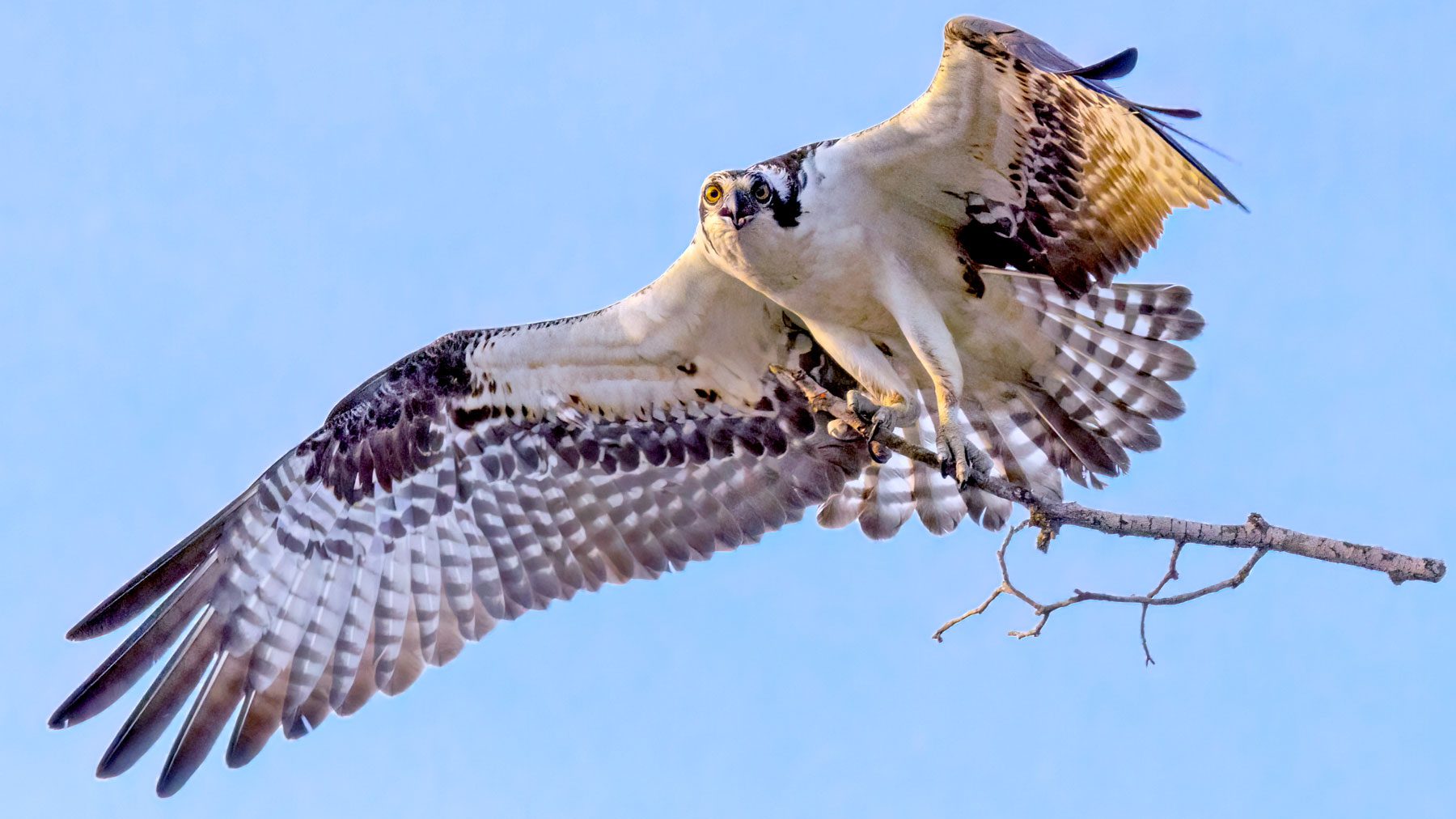
From the Spring 2025 issue of Living Bird magazine. Subscribe now.
For Bryan Watts, the Chesapeake Bay’s thriving Osprey population provided a rare ray of hope in his four decades of work as a conservation scientist.
The local population crashed during the 1960s and ’70s due to the widespread spraying of DDT and other pesticides, but it began to rebound in the 1980s and ’90s, a recovery documented in surveys conducted by local scientists. By 2020, over 10,000 breeding pairs of the fish-eating raptors called the Chesapeake home.
Which is why Watts, who is director of the Center for Conservation Biology at The College of William & Mary, was shocked when he noticed Osprey nests along the main spine of the Chesapeake Bay in Virginia and Maryland were failing. Something, he reasoned, must be wrong.
It was. Watts’s nest survey data in 2023 showed that Osprey reproduction rates in one corner of the Chesapeake had sunk even lower than before the DDT ban in the 1970s, with only 17 of 167 nests containing live chicks in one survey. The cause—according to a subsequent study by Watts and fellow William & Mary scientists published in the journal Frontiers in Marine Science in January 2024—was inadequate numbers of a smallish, oily baitfish called menhaden that form the bulk of the Osprey diet in the Chesapeake. Large numbers of Osprey pairs weren’t laying eggs; many of those that did couldn’t keep their chicks alive to fledge. Adult Osprey, it seemed, couldn’t find enough fish to create the next generation of birds.

A major clue to the cause comes from Chesapeake tributaries like the James and Potomac Rivers. There, Osprey rely more on other fish species, and population levels of the raptors have continued to climb. To Watts, this discrepancy strongly suggests that a lack of menhaden is causing Osprey numbers to crash.
Not everyone is convinced by Watts’s conclusion. Omega Protein is the only commercial fishing company that processes menhaden in the Chesapeake and mid-Atlantic waters, processing them into fish meal and fish oil. On its website, the company—which is permitted to harvest about 112 million pounds of menhaden from the bay every year—states that the Atlantic menhaden fishery is not being overfished. Omega Protein points to its Marine Stewardship Council certification as a sustainable fishing operation. In 2012 and again in 2017 the Atlantic States Marine Fisheries Commission lowered caps on menhaden fishing, and the company says that further limits are unnecessary.
Robert Latour, a fisheries biology professor at the Virginia Institute of Marine Sciences, agrees that there’s not enough data to say with certainty what’s going on.
“I don’t think we know enough to make dramatic changes in policy,” Latour says.
Yet Watts insists that the lines of evidence exist connecting Osprey and menhaden: “We know what’s going on because we’ve watched it in real time. We’ve watched these chicks die of starvation.”


A Parade of Empty Nests in Mobjack Bay
On a hot morning last June, Watts secures his tattered baseball cap with a tug before easing his skiff into the tranquil brackish waters of Mobjack Bay, on the western shore of the Chesapeake. With bronzed skin and a neatly trimmed beard tinged with gray, Watts looks more like a waterman than an ornithologist. He has performed this ritual countless times, his motorboat almost seeming to steer itself to the first nest on his list, just off the docks. Even at high tide, the wooden platform used by the would-be Osprey parents towers above. Only when Watts extends a telescoping mirror overhead can he see inside.
“Empty,” he mutters, before opening the throttle and heading to the next nest. The process repeats itself as Watts checks nest after nest. Adult Osprey sit on the wooden platforms—many built by local homeowners at a cost of several hundred dollars each—but no nest contains chicks. Finally, on the eighth nest, the drought breaks.
One chick seems oblivious to Watts’s presence. Its sibling extends a large head to glare into Watts’s telescoped mirror with a fiery orange-red eye. The mother circles overhead, her shrill alarm call echoing off the Mobjack’s open waters. Watts scribbles down some measurements and moves off, and the female quickly returns to her chicks.
At the next nest, Watts logs a single surviving chick. When he last checked the nest several days before, he noted two young, although one chick was clearly larger and stronger than the other. This size differential is a clear marker of food stress, Watts says.
Watts has been crisscrossing the lower reaches of the Chesapeake and watching new generations of Osprey emerge from eggs and become adults since the late 1980s, when he was a master’s student in biology at William & Mary assisting on the Osprey nest survey program. He became fascinated by the Osprey as a species that’s an obligate piscivore (or bird that only eats fish).


“Their whole ecology has evolved around fish. Their feet are adapted for fish. They have specialized scales on their feet for gripping fish,” Watts says. “Everything about them is about fish.”
Back in the ’80s, Osprey were beginning to recover from the impacts of DDT, which had left eggshells too fragile for the next generation to hatch. After the pesticide was banned in 1972, Osprey slowly began to rebound. Some of Watts’s first tasks as a student involved tracking the number of nesting pairs to quantify their incredible recovery. From a low of 1,500 breeding pairs in the Chesapeake in the mid-1970s, numbers more than quintupled by the mid-2010s.
After a short stint at the University of Georgia for his PhD, Watts returned to William & Mary and the Chesapeake in 1991. His research interests have broadened to include other bird species, including Red-cockaded Woodpecker, Peregrine Falcon, and Black Rail. But he retained a love for Osprey. No other species more closely reflects the health of the bay, he says. And if Osprey are struggling, it’s only a matter of time until other birds are, too.
The popularity of artificial nesting platforms has provided homes not just for Osprey, Watts says, but also for sparrows and other small songbirds that sometimes make their own nests on the edges of the Osprey edifice. Since Osprey eat only fish, the songbirds reap the protection of the raptors without becoming lunch themselves.
With such a thriving population, the annual nest counts conducted by William & Mary scientists might have seemed like overkill. But thanks to their exclusive diet of fish, the health of the Osprey population also provides scientists with an effective barometer of fish abundance and the overall health of the bay—which made it all the more alarming when Watts started recording declines in Osprey fledglings several years ago. In 2021, Watts logged only one young Osprey for every three nests, far below the average needed to maintain the population.

Testing the Menhaden–Osprey Connection
In 2021 Watts set up a small experiment to study the connection between menhaden and healthy Osprey nests. He worked with Michael Academia, a William & Mary master’s student he was advising, to supplement some Osprey nests in Mobjack Bay with extra menhaden, while leaving other nests alone. While the supplemented nests did well, the control group continued to decline. Watts cast an even wider net in 2024, recruiting Barnett Rattner, an ecotoxicologist with the U.S. Geological Survey in Maryland. The expanded team recorded declines in Osprey numbers across the entire bay.
When Watts looked closely, he found clear indicators that Osprey chicks were starving in the nests. To him, that indicated a clear problem with the Osprey’s favorite fish: menhaden. If Osprey sit at the top of the Chesapeake food web, menhaden are near the bottom. Schooling in shoals by the thousands, menhaden are the perfect fun-sized candy bar for marine life.
Osprey love menhaden for the same reason that humans do, namely the high oil and energy content. But while Osprey eat menhaden as is, humans process it for use as fertilizer, fish feed, and protein and pet food supplements.
Omega Protein insists that menhaden stocks are not being overfished. In response to a request for comment, an Omega Protein spokesperson said: “The Atlantic States Marine Fisheries Commission manages the menhaden fishery using the latest scientific data to set harvest limits that prevent overfishing. The fishery operates within these quotas, ensuring that menhaden remain abundant while still supporting commercial harvesting.”
More on Ospreys on the U.S. East Coast
But others say that fishing pressure on menhaden in the Chesapeake Bay needs more scrutiny. The state of Maryland prohibits large-scale menhaden fishing in state waters. Virginia, however, has not. The Chesapeake Legal Alliance petitioned the state in December 2023 for stricter regulation of menhaden fishing and a formal study to assess the size and health of the menhaden population, but officials declined to act.
Chris Moore, Virginia executive director of the Chesapeake Bay Foundation, says that the combination of environmental stressors in the bay—like pollution, development, and climate change—and strain from industrial-scale fishing demand a more precautionary management approach.
“Virginia is the only state on the Atlantic coast that still allows menhaden reduction fishing in their state waters,” Moore says. “If you look, we see some very worrying signs out there.”
Fishing outfitter Chris Dollar agrees with Watts that declining menhaden populations are causing ripple effects throughout the Chesapeake food chain. Dollar has spent many afternoons along the Rappahannock River, north of Mobjack Bay, and says he now rarely sees the football field–sized schools of menhaden that were once far more frequent. He’s also seen declines in sportfish like red drum and bluefish that, like Osprey, depend on menhaden.
“Menhaden are the one factor that ties all of this together,” Dollar says. “I want proof that it isn’t menhaden.”
In August 2024, ASMFC established a working group to recommend a menhaden action plan that will balance the needs of fisheries and wildlife. The issue grew more contentious when a formal response pushing back against Watts’s work by Latour and two other VIMS scientists was published in Frontiers in Marine Science in October 2024. They point out that although Osprey reproductive difficulties are concerning, any number of factors could be contributing to nest failures, including predation, disease, climate change, and, yes, menhaden.
“There’s so much we just don’t know still,” Latour says. “Until we can study Osprey and menhaden together, we will just be guessing.”
Even Watts’s collaborator Rattner at the USGS, who has documented the starving chicks and empty nests, says he still cannot conclusively tie it to the Osprey’s inability to find menhaden.
“There is good evidence there’s something going on,” Rattner says. “I think some of it is related to food availability, but I haven’t been able to rule out other factors.”
Watts also admits he could be wrong, but he doesn’t think he is. He has submitted a rebuttal to Latour’s commentary that is currently in review. Until someone can provide him with adequate data that menhaden populations are not crashing, he will continue his Chesapeake vigil.
“In the end, I think things will be sorted out. That’s what happened with DDT,” Watts says. “It was the public who ultimately decided we didn’t want to see these species disappear, and they decided they wanted the species more than they wanted some of the pesticides. And so there was a rule change.”
As Watts opens the throttle on his boat to return to the dock, an Osprey soars overhead, its crystalline cry simultaneously fierce and fragile. The bird folds its wings and plummets toward the water. Its talons emerge, empty. Shaking the water from its feathers, the osprey flies off in pursuit of better luck.
About the Author
Carrie Arnold is a freelance journalist who reports on health and the environment. She lives in coastal Virginia. She has previously written for Living Bird about Marbled Murrelets and Clark’s Nutcrackers.

